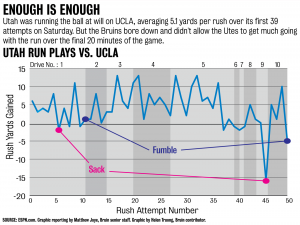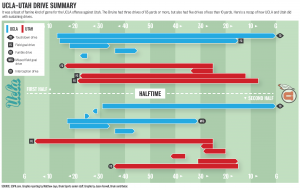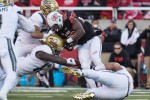Each week, Daily Bruin Sports takes a look at the game film for UCLA football and grades each position group on its performance. This week, we examine UCLA’s 17-9 win over Utah.
Quarterbacks: A-
It was another day of improvement for freshman quarterback Josh Rosen. This time, he didn’t run up crazy numbers on the stat sheet – going 15 for 30 for 220 yards and a touchdown – but he did the intangible things well, such as calling audibles at the line of scrimmage and managing the game.
Rosen had two key audibles on UCLA’s first two drives, going up to his offensive linemen before the play to change the call. The first audible came on UCLA’s first drive, before a third-and-6 play from the 50-yard line that resulted in a 16-yard completion to redshirt junior receiver Kenny Walker on a right-side curl route.
The second audible from Rosen came on a third-down play on UCLA’s second drive. With UCLA facing a third-and-5 opportunity from the Utah 28, Rosen audibled to a run play, and redshirt junior Paul Perkins rushed forward for a 17-yard gain – his best run of the day. UCLA went on to score a field goal later in that drive, giving the Bruins a 10-0 lead.
Overall, Rosen was impressive in this game not because of what he did on the stat sheet, but because of what he did off of it. He stood in the pocket firmly, he made intelligent audibles and he even drew up a play on the whiteboard at halftime, according to coach Jim Mora and senior wide receiver Jordan Payton. Rosen just appears to be growing each week, whether it be in his pass efficiency or his leadership abilities.
Running backs: C-
It’s hard to grade the UCLA running backs on their running ability in this game, as there just weren’t many holes to run through. The Utah front four had its way with the UCLA offensive line all day, leaving Perkins and freshman Soso Jamabo with little room to run.
Credit Perkins for being able to slither through the smallest of creases – as he usually does – but it was a relatively pedestrian day for the former Pac-12 rushing champion. Perkins finished the game with 98 yards on 28 carries.
Since the running backs really can’t be graded on their running ability, their pass-blocking ability becomes the focus here, and both Perkins and Jamabo had their issues with containing the Utah blitz. Perkins missed a block that led to a near-fatal fumble by Rosen in the fourth quarter, and Jamabo missed a chip block on the play where Rosen was sacked for an 8-yard loss in the third quarter.
Wide receivers: A-
Once again, there wasn’t a lot of depth shown by the UCLA wide receiver group, but it’s gotten to the point where that doesn’t seem to matter. Payton and junior Y receiver Thomas Duarte have proven that they can carry the load themselves.
On UCLA’s first drive, Duarte made his only two receptions of the game, each of which went for 25-plus yards, helping the Bruins get their first touchdown of the game.
On the rest of UCLA’s drives, Payton was the bedrock that helped UCLA move the ball. Four of Payton’s seven catches came on third down, with each of those four catches gaining first-down yardage. None of Payton’s third-down receptions were more important than his 12-yard comeback route on UCLA’s first drive of the second half. That play kept UCLA’s drive alive inside the Utah 25-yard line, and the Bruins would go on to score a touchdown five plays later.
Outside of Duarte and Payton, slot receiver Darren Andrews added his usual dosage of bubble-screen catches. The redshirt sophomore had three on the day, all of which were effective. But once again, the effectiveness of Andrews and the UCLA receiving corps goes back to Payton and Duarte, as that duo provided some punishing blocks on each of Andrews’ three bubble screens.

Offensive line: D+
First, let’s start with the positives: UCLA didn’t have one false start this week, and only committed one holding penalty.
Now, to begin the negatives, pass protection comes first. UCLA’s offensive line allowed Rosen to get hit in the backfield on eight of his 32 dropbacks. Sure, the Bruins only allowed one sack in the game – which is a huge improvement from the 10 sacks they allowed against Utah last year – but still, the offensive line made it very difficult for Rosen to find a clean throwing lane on many of his throws.
As for the run blocking, it was just about as bad. UCLA averaged 2.8 yards on its 38 carries, with the offensive line being hammered by a strong front four from Utah.
“I think most of the credit for our offense to struggle should go to Utah’s front,” Mora said. “That’s about as good of a front as you’ll find in college football.”
If not for Rosen and Perkins being the standout players that they are, UCLA may not have scored a point against Utah’s defense.
Defensive line: A-
This unit was pushed back a little bit at the start of the game, but held up strongly when it counted. Starting with a goal line stand on Utah’s fifth drive, UCLA’s front four was dominant.

Part of the reason for the late-game improvement was an installation of some coaching “adjustments” midway through the third quarter, Mora said. Those adjustments included moving defensive linemen into different positions right before the snap. So, for example, redshirt junior defensive lineman Eli Ankou would begin a play lined up between the Utah left tackle and left guard. Then, right before the snap, he’d move directly in front of Utah’s left guard.

“That just kind of threw their whole (rhythm) up,” said defensive end Takkarist McKinley, who had two tackles for lost yardage against Utah. “Just because, at the last second … they were like, ‘Who’s got who?’”
With the UCLA defensive line adjusting well, Utah was only able to gain 1.6 yards per carry on its final five drives – not including a 16-yard sack in the fourth quarter.
Linebackers: A-
Aaron Wallace is the only senior on UCLA’s starting defense – and a redshirt senior at that – and he sure looked like it against Utah.
Wallace was making disciplined plays left and right against the read-option, ensuring neither Utah running back Joe Williams nor Utah quarterback Travis Wilson could break to the outside. Thanks to Wallace’s strong gap integrity on the edge, the Utes were only able to gain 2.0 yards per carry on their 16 runs to the outside.



Even though Wallace was plugging up runs to the outside-right, the middle was a weak point of the Bruin defense for much of the day. Utah gained 157 yards (5.6 yards per carry) on its 28 designed run plays up the middle, plowing over UCLA at the point of attack for the first two-and-a-half quarters. The Bruins struggled particularly with defending the zone read, as they have many times over the past year.
But give the Bruin defenders credit, as they were able to plug up the holes up the middle in the game’s waning moments. The Bruins held the Utes to -4 rushing yards over their final 13 attempts in the game, taking away the main aspect of Utah’s offense. During that 13-carry span, UCLA picked up a red-zone stop, a sack by Wallace and a fumble recovery by junior inside linebacker Jayon Brown.
“I thought probably the biggest play of the game was the stop at the goal line (on Utah’s fifth drive, midway through the third quarter),” said defensive coordinator Tom Bradley. “That was a game-changer right there.”
It certainly was. UCLA applied a slightly altered scheme on the defensive line from that point forward, and Utah couldn’t adjust. This game marked one of the first times this year that UCLA’s run defense actually got better as the game went on. The losses to Arizona State and Stanford, as well as the game against Arizona, showed the opposite trend.
Defensive backs: A+
Freshman safety Nate Meadors has made quite an impact in his short time on the field this year.
Against Colorado, Meadors stepped in at cornerback – a position he had never played in his life – and made the game-winning interception.
Against Utah, Meadors was once again asked to step in at corner, as redshirt sophomore cornerback John Johnson sat out with a neck injury. He didn’t miss a beat.
Meadors was targeted four times by Wilson, but didn’t allow one completion. He also had a key pass breakup on a third-and-5 play on Utah’s sixth drive, forcing a Ute punt. Aside from that, Meadors came up and made a strong tackle on a shovel pass during Utah’s third drive, forcing the Utes into a fourth-and-3 situation.
The fact that Meadors is technically a third-string corner is a testament to the strength of this UCLA defensive back group. Although the unit had some difficulties with Washington State, it has been a strength for most of the year.
After a strong performance against Utah – allowing only 13 completions for 110 yards – the Bruins rank No. 1 in the Pac-12 in pass defense, allowing just 208.5 yards per game and 5.6 yards per attempt.
Special teams: A
Although senior kicker Ka’imi Fairbairn missed his first field goal since opening day against Virginia, he more than made up for it with his efficiency in the kickoff game. All four of Fairbairn’s kickoffs went for touchbacks, giving him a Pac-12-leading 55 touchbacks on the year.
Aside from Fairbairn, senior punter Matt Mengel helped UCLA control the field-position game against Utah. Mengel averaged 46.3 yards per punt – more than 7 yards beyond his season average heading into the game – and landed three punts inside the 20. With Mengel stepping up, the Bruins were able to control the field-position game for the first time in weeks. By game’s end, Utah’s average starting field position was at its own 22-yard line.

One more note on UCLA’s special teams: Redshirt senior running back Roosevelt Davis came in for his first two kick returns of the year, and provided a considerable spark. Each of Davis’ returns went past the UCLA 30-yard line, a vast improvement over sophomore running back Nate Starks, who was only able to get to the 13-yard line on his lone return.
